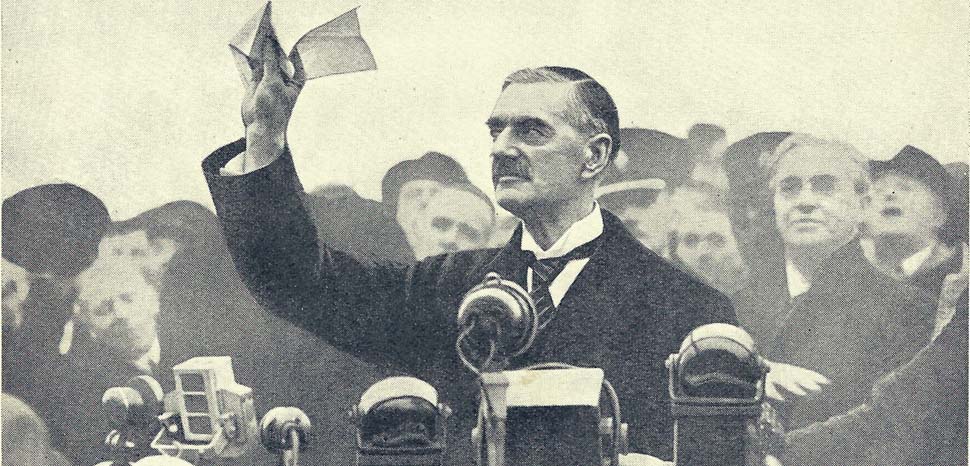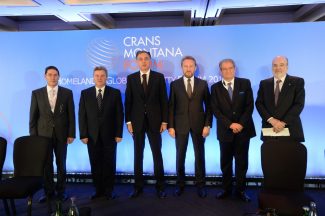In the late 1930s, the British diplomat and scholar Edward Hallet Carr finished writing The Twenty Years’ Crisis: 1919 – 1939, one of the most seminal books in the field of international relations scholarship, and one that is still widely read by most contemporary geopolitical analysts. The work – fatefully published a few weeks before World War Two broke out– discusses the ultimate folly of utopian thinking regarding the grandiose expectations related to the overall prospects of everlasting peace, prosperity, and co-operation amongst national states. In blunt terms, it dismisses attitudes, calculations, and actions derived from wishful thinking and daydreaming.
From a very anthropologically pessimist perspective (consistent with the ideas of classical realists like Thucydides, Hobbes, Chanakya and Machiavelli) E. H. Carr pointed out that faith in the goodness of human nature was a recent and dangerous heresy. After all, instead of seeing “an arc of the moral universe that bends towards justice” – as the traditional creed of ‘Whig historiography’ suggests – the world was witnessing phenomena like widespread economic turmoil, a dramatic financial collapse, the ascent of both fascism and communism, increasing systemic geopolitical tensions, the aggressive proliferation of militarism in Europe and Asia and boiling socio-political agitation in several nations. Moreover, the League of Nations had been rendered useless and, far from bringing peace, the so-called “War to End All Wars” engendered a great deal of resentment, with scores waiting to be settled.
In other words, the book can be seen as powerful reminder that the human condition is irrevocably flawed – given its timeless and universal proclivity to maximize wealth, power, and prestige – and that naïveté about the unchangeable nature of political power is a luxury that no sensible statesman can afford, regardless of his or her best wishes. Accordingly, in the realm of high politics, hope can never be regarded as a valid component of grand strategy. Hence, even if Carr’s book examined a very specific context, its lessons are instructive for future generations, especially when it is necessary to envisage how events will unfold when the horizon in a foreseeable future looks rather ominous. Those that neglect such teachings usually end up experiencing a rude awakening.
The Post-Cold War era as a time of misguided optimism
The end of the Cold War ushered a period of rampant intellectual triumphalism. The thinkers and theorists that peddled the so called ‘end of history’ held that Western-style liberal democracy and free markets would reach all corners of the world, something that would fuel an unprecedented wave of prosperity and freedom. Accordingly, bellicose geopolitical rivalries would supposedly be replaced by peaceful economic competition. Even intelligence agencies debated the redefinition of new threats and refocusing their priorities.
Furthermore, galvanized by the arrival new technologies, cheaper means of transportation, growing commercial dynamism, fewer restrictions, global connectedness projected the illusion of a seemingly borderless ‘global village’ where there was room for endless absolute gains for everybody. Zero-sum thinking was maligned as an anachronism and issues like local conflicts, failed states and climate change were seen as problems that could be feasibly handled through multilateral collaboration and diplomacy.
Hence, the spirit liberal internationalism flourished during the 90s, whose influence shaped events like the reunification of Germany; the formal establishment of the European Union; the introduction of the euro as the first modern supranational currency; the creation of NAFTA; the transnational extension of logistical chains; favorable conditions for the relatively unrestricted movement of capital, goods, and people; the pursuit of a conclusive diplomatic solution for the Israeli-Palestinian conflict; and theoretical discussions about the need to widen the concept of human rights.
Furthermore, Turkey wanted to join the EU, Russia was eager to embrace the West after decades of mutual animosity and the economic rise of China was regarded as a peaceful development that would provide attractive opportunities for business, trade, and investment. On the other hand, countries like North Korea, Cuba and Iran were seen by the international community as ‘pariah states’ isolated from the civilized world.
In policymaking and academic circles, this period was portrayed as the new normal and skepticism about its long-term prospects was met with derision and mockery. Thus, the resulting brand of globalization was even described as irreversible. It was here to stay and it was assumed that its challenges would eventually fade away.
The return of History
Despite the atmosphere of prevailing enthusiasm, the first major shock came with the 9/11 terrorist attacks. The most powerful nation on Earth was attacked by al-Qaeda, a loose transnational Islamist network. Such an unforeseen event was a sign that, even though the prospect of open military confrontation involving the greatest powers was unlikely due to the deterring influence of vast nuclear arsenals, emerging unconventional threats should not be underestimated.
Ultimately, Washington’s response led to the invasion of both Afghanistan and Iraq. Overthrowing the Taliban and Saddam Hussein proved to be easy for the United States and its allies but both operational theaters turned out to be quagmires that absorbed countless amounts of resources associated not just with power projection, but also with costly nation-building efforts, including troops, military hardware, funds, training, reconstruction, and diplomatic energy. Now decades later, Afghanistan and Iraq still have not been pacified and Islamist terror still runs amok in the Middle East, Central Asia, the Maghreb, and even Europe itself. Another noteworthy consequence of the Iraq war was a growing rift between the US and the Franco-German axis, the very core of the European Union. This is remarkable because, during the preceding decades, a strong transatlantic consensus was taken for granted.
The next major disaster was the global financial crisis that took place in the late 2000s. It generated chaos, recessions, unemployment, instability, insolvency and a massive credit crunch. Although unorthodox measures were implemented to overcome it, the underlying structural shortcomings are still there, including the accumulation of unpayable debts, the growing disengagement of speculative finance from productive economic activity, the uninterrupted application of unsustainable monetary policies like quantitative easing, and the prevalence of low interest rates that favor consumerism instead of savings.
Furthermore, the monetary hegemony of the US dollar has been practically kept on life support, provided by its symbiotic connection to American military strength and its unmatched supremacy in commodity markets. In other words, it has been backed by both lead and oil. In the grand scheme of things, this puts even the long-term credibility of fiat money itself at risk and, not surprisingly, several states are preparing to establish conduits to bypass US financial circuits and, if possible, to create a parallel monetary order outside the control of Washington and Wall Street. The financial architecture of the world might thus be redesigned in a foreseeable future, but it is unknown at this point how smooth the process will be. It must be borne in mind that – throughout history – there has been a close correlation between the realms of geopolitics and finance.
In Europe, the integration project gained a lot of traction at first and the EU even incorporated former Warsaw Pact members and Baltic states which used to belong to the Soviet Union. However, its limitations soon became evident in the divergent interests, needs, imperatives, economic profiles, and cultural background of its member states. Ironically, it became a victim of its own success. Gaps have become increasingly difficult to bridge and the generation of substantial consensus has proved to be elusive. Moreover, without NATO’s nuclear umbrella –provided by the Pentagon – Europe has no credible defense policy. It cannot even reach an agreement concerning the identification of threats. Additionally, European societies have been flooded by waves of immigration, whose successful assimilation prospects are, at best, feeble.
Brexit has clearly demonstrated that integration is not irreversible and right now the fates of the EU as an entity and the euro as a currency are in peril because of both an accumulation of structural imbalances and, more recently, the destabilizing impact of the recent COVID-19 pandemic in several European societies. In order to keep things in perspective, the danger posed by the recent outbreak has been portrayed by senior European leaders as the most challenging crisis since World War Two.
Though the rise of China has been peaceful in the sense that it has not unleashed direct military confrontation, that does not mean that tensions have not been brewing as a result of it. India, Japan, and – more importantly – the US are weary of growing Chinese national power in the fields of military strength, economic might, financial clout, cultural influence, diplomatic reach, and technological development. In terms of grand strategy, it looks like China intends to challenge American hegemony or at least to position itself as the cornerstone of a parallel bloc. Therefore, both powers can be rapidly engulfed by the vortex of a potentially explosive ‘Thucydides trap.’ Moreover, rather than implementing democratic reforms, China has become increasingly authoritarian over the past decade.
Concerning the post-Soviet space, Russia has not joined the West or followed its footsteps regarding the political model of liberal democracy or the economic recipe of free markets. Instead, Moscow has been trying to reassert its national power and to restore its hegemony in the ‘near abroad.’ The Kremlin has also projected its geopolitical influence in other regions as well, including the American hemisphere itself. Russia has even managed to weaponize the supply of energy as a tool of geopolitical and geoeconomic arm-twisting based on potential disruption rather than sheer force. Another fact worth emphasizing is Moscow’s willingness and ability to use military force through both overt (Georgia, Syria) and covert conduits (Ukraine).
In the Middle East, the so called two-state solution is arguably dead for all intents and purposes. The rise of Iran – expressed in its imperial project to attain regional hegemony through the so-called ‘Shiite Crescent’ – made the Gulf Cooperation Council Arab states and Israel strange bedfellows, whose common denominator was the geopolitical imperative to curb Tehran’s ambitious designs. Furthermore, Iranian expansionism has fueled both Sunni jihadism and sectarian carnage in places like Syria, Iraq, Yemen, and Lebanon. Likewise, the economic and political failure of secular dictatorships throughout the Arab world has not encouraged democratic reformism, but rather militant Islamism, contrary to expectations.
Latin America is no exception. Once seen as a region with promising potential regarding democratic reforms and economic liberalization, it has performed with mixed results. Some Latin American countries – Brazil, Chile, Mexico, Argentina – have reached considerable levels of economic development, but most of these nations still face structural challenges like poor governance conditions, rampant crime, drug wars, socio-political discontent, and toxic levels of domestic polarization. Furthermore, the Bolivarian axis has fanned the flames of agitation with petrodollars and – although weakened by economic mismanagement, falling oil prices and political setbacks – its undemocratic model still prevails in places like Venezuela, Cuba, and Nicaragua and its covert tentacles are still active elsewhere in the region.
On the other hand, technological progress has enabled improvements in all walks of everyday life, including business, finance, education, healthcare, travel, research, leisure, and even personal interaction, but it has also acted as a double-edged sword considering the role it has played in the development of cyberwarfare capabilities, the militarization of outer space, the growth of illicit markets in the deepest corners of the ‘dark web’, the introduction of invasive surveillance systems that have essentially extinguished personal privacy and the intentional dissemination of misleading content throughout the info-sphere.
Moreover, the combined potential associated with the leading sectors of the Fourth Industrial Revolution entails the ability to design cutting edge weaponry that integrates quantum computing, artificial intelligence, access to big data and nanotechnology, amongst others. Likewise, the arrival of renewable energies will not prevent strategic competition motivated by the control of its sources; it will simply adjust the existing parameters of the equation. For instance, harnessing solar energy will likely encourage geopolitical rivalries in order to dominate planetary regions with an optimal degree of direct insolation.
In terms of ideology, liberal internationalism has been fading into irrelevance. In today’s world, nationalism is the norm, as the cases of the US, France, Russia, China, Turkey, Israel, Iran, Japan and the Philippines illustrate. Furthermore, civil liberties have been surrendered for the sake of countering dangers like crime, terrorism, and infectious diseases. Far from eroding, the national state is stronger than ever before, contrary to the expectations of the theorists that prematurely wanted to bury it, along with the notion of sovereignty. Plus, pervasive surveillance systems –including scanners, electronic espionage and facial recognition software – are rapidly becoming the rule rather than the exception. Even remarkably different societies like China and the United States share this common denominator.
As a somber corollary of this period, the rapid global expansion of the current coronavirus outbreak threatens to overwhelm countless national healthcare systems, but it also endangers economic dynamism and – in some cases – financial stability, effective governance conditions, and even the rule of law. The full extent of its disruptive effects remains to be seen, but it is certainly discouraging open borders, the free movement of people, domestic consumption, international trade, multilateralism, and tourism. In fact, it can be seen as a vector that undermines the spirit of liberal internationalism and everything it stands for.
When it comes to dealing with this highly unconventional threat, every society is defining its own priorities based on its circumstances, resources, and interests. Instead of a “global village” or an “international community”, what the world is witnessing resembles more the textbook depiction of a Hobbesian “state of nature.” As a result of the unforgiving forces of nature, a gloomy spectre of uncertainty and fear haunts the world right now.
Lessons learned
In the grand scheme of things, periods of optimism and hopefulness are the exception rather than the rule. They are the product of extraordinary circumstances and the enthusiasm they stimulate can eventually turn out to be groundless when analyzed in hindsight. More often than not, such periods act as a prelude to a new era of hardship and struggle against the odds. After all, recorded history is an unbroken sequence of glorious triumphs and achievements but also of disappointing defeats and tragic calamities. In a sense, its behavior can be regarded as cyclical.
In this drama, some national states perform better than others. Some societies flourish once they have managed to overcome substantial challenges and others simply fade into oblivion. In other words, if one envisages the state as a living organism, its existence is shaped by the law of natural selection. If it is unable to adapt to changing surrounding conditions, then its existence is in jeopardy.
Moreover, it is evident that the human condition has changed little since the time of the Pharaohs. Under conditions of deep systemic chaos, danger, scarcity and uncertainty, societies cannot afford to delegate their survival or rely on the kindness of others. If they do not meet their vital needs, they perish. However, such context is especially dangerous because it multiplies the intensity of incompatible strategic agendas.
Likewise, wild cards – like the current global coronavirus pandemic – can operate as catalysts for structural geopolitical and geoeconomic readjustments. The outcome is not fully clear but there are different plausible scenarios depicted by seasoned strategic forecasters. Interestingly, one of the few common denominators they happen to share is that this phenomenon will certainly provide examples of the noblest and vilest things human beings are capable of. For those well versed in history, that is hardly surprising.
Finally, the most important lesson of this analysis is that, as paradoxical as it sounds, chaos and order can be seen as two sides of the same coin.




